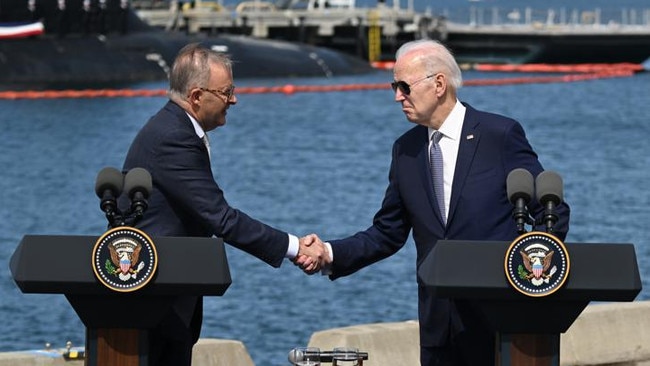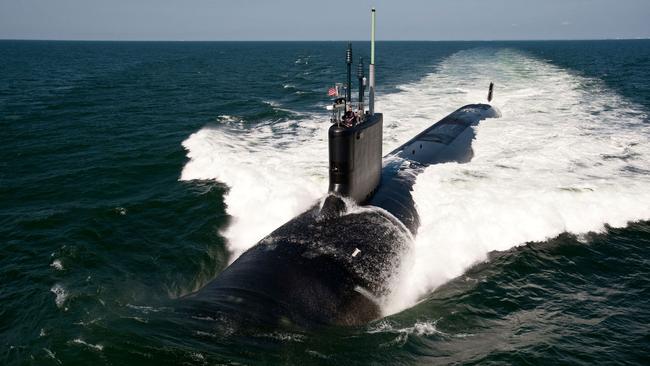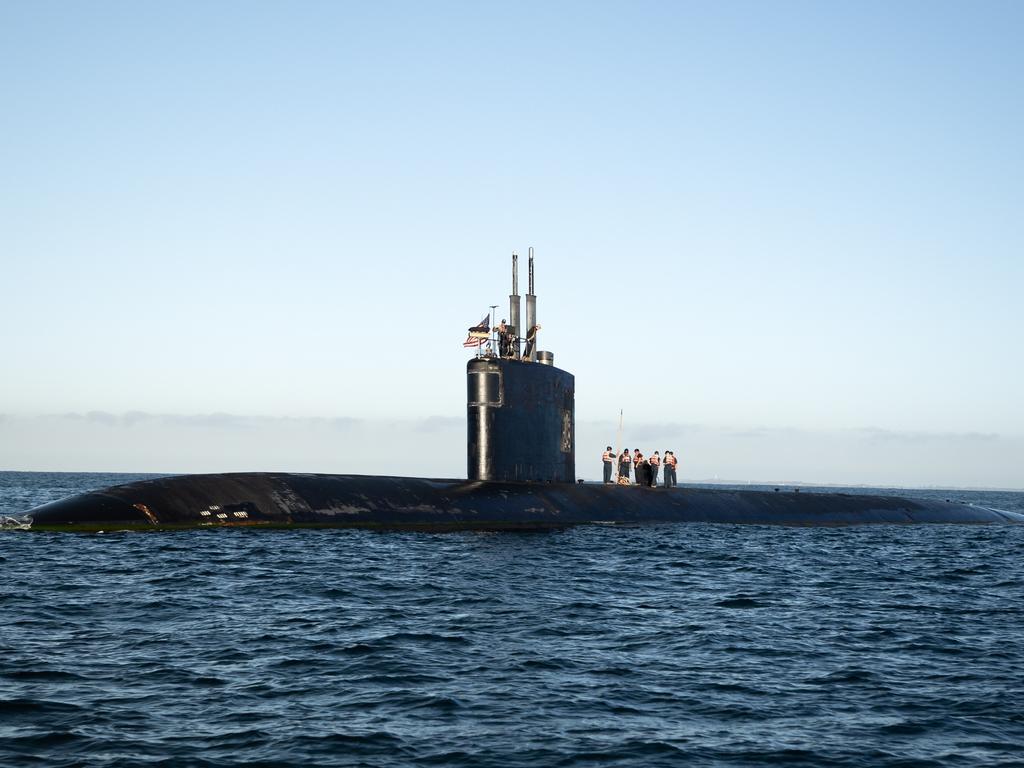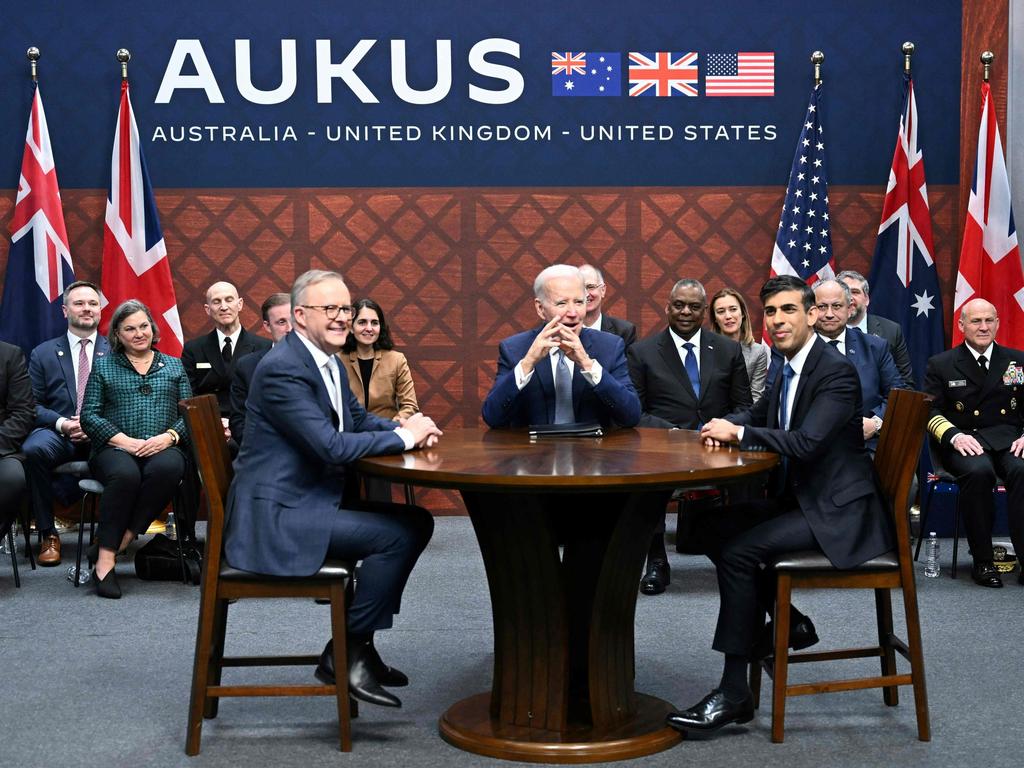
Pillar Two, comprising advanced defence technologies such as cyber, artificial intelligence, quantum technologies, the undersea domain, hypersonics and counter-hypersonics, was given significant prominence when President Joe Biden announced the tripartite pact in 2021. Yet neither he nor prime ministers Anthony Albanese or Rishi Sunak as much as mentioned these initiatives from the stage in San Diego.

Of course, the need to formulate a plausible plan to replace Australia’s diesel-powered Collins-class submarines – Pillar One – was extremely urgent. Since the cancellation of the French-designed conventionally powered Attack-class 18 months ago, a frenzy of hand-wringing about capability gaps had dominated the public discourse.
The Pillar One plan – to extend the life of the Collins, introduce the rotational presence of nuclear-powered submarines from the US and UK through Perth, purchase three to five Virginia-class boats from the US and finally design and build an SSN-AUKUS with the UK – is an “all of the above” response. The collective work done to achieve it across three governments has been immense and should be applauded.
Yet the omission of Pillar Two technologies from this announcement will reinforce the fear that the challenge of nuclear propulsion for Australia has caused a cognitive overload, rendering all other advanced defence technologies a distant afterthought. This would be a strategic mistake.
There is every reason to imagine some Pillar Two technologies could be deployed before Australia obtains nuclear-powered submarines in the early 2030s. Given the ever shorter time frames before potential conflict in our region, this is not a trifling matter.

Pillars One and Two are not mutually exclusive. We may see hypersonic and counter-hypersonic missiles deployed from Australian SSNs in the future. A key reason for needing larger, abundantly powered boats is to facilitate the deployment of unmanned undersea vehicles. Quantum timing and navigational discoveries could be crucial for all naval vessels if GPS satellites are disabled during conflict. And cyber already factors into every vessel, platform, decision and domain. It is no exaggeration to say Pillar Two technologies will be vital for the success of Pillar One.
Crucially, Pillar Two technologies offer the more convincing case for economic spillovers. Experts have repeatedly warned that while direct jobs in the nuclear navy and in the industry will be high-skilled and well-paid, they will not generate the economic renaissance that is sometimes claimed. Conversely, the Pillar Two technologies typically begin with research at Australian universities, generating new intellectual property and leading to products with both defence and commercial applications, with export potential.
Finally, it is not impossible to imagine yet-to-be-discovered applications of Pillar Two technologies one day rendering the relatively mature submarine concept obsolete, whether through improved detection technologies or truly autonomous and unmanned underwater vessels, or a combination of both.

It is also an open question who has responsibility for Pillar Two in Australia. The government is continuing to examine its election pledge of an Advanced Strategic Research Agency modelled on the longstanding US agency DARPA (Defence Advanced Research Projects Agency) and the recently created UK equivalent, ARIA (Advanced Research and Invention Agency). Issues such as the necessary scale and avoiding duplication of effort with Defence Science and Technology Group, particularly its renowned STaR Shots program, will all have to be convincingly addressed.
There are also well-known bureaucratic roadblocks to AUKUS technology-sharing such as the US International Trade and Arms Regulations, which, reports suggest, are the subject of ongoing discussions between the partners. This may come to a resolution with a bill currently before the US Senate requiring the Department of State to report to congress on implementing Pillar Two, including matters such as the time taken for the US government to review applications for export licences and recommending changes to the export control laws and regulations of the three partner countries.
Pillar Two may not naturally lend itself to another grand public presentation the way the original AUKUS deal and the recent nuclear-powered submarine announcement both did. It is unreasonable to expect to see President Biden and prime ministers Albanese and Sunak reunite regularly in front of the latest gadget and hail mere multimillion-dollar investments. But real evidence must soon be forthcoming that AUKUS genuinely stands atop both the pillars that were promised.
Justin Burke is the Thawley Scholar at the Lowy Institute and Center for Strategic and International Studies in Washington.








Notwithstanding the blockbuster announcement on nuclear-propelled submarines for Australia earlier this month, it is hardly churlish to point out the second major pillar of AUKUS was completely omitted.